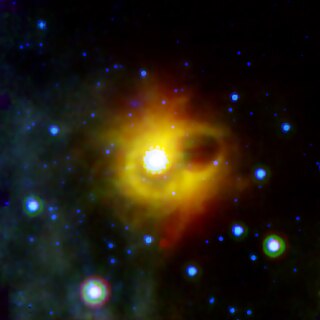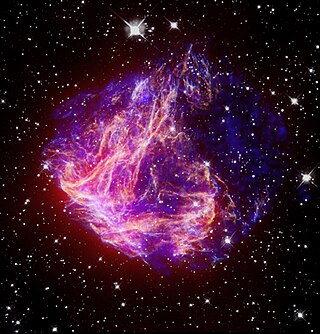Related Research Articles

A neutron star is the collapsed core of a massive supergiant star, which had a total mass of between 10 and 25 solar masses (M☉), possibly more if the star was especially metal-rich. Except for black holes, neutron stars are the smallest and densest currently known class of stellar objects. Neutron stars have a radius on the order of 10 kilometers (6 mi) and a mass of about 1.4 M☉. They result from the supernova explosion of a massive star, combined with gravitational collapse, that compresses the core past white dwarf star density to that of atomic nuclei.

In gamma-ray astronomy, gamma-ray bursts (GRBs) are immensely energetic explosions that have been observed in distant galaxies. They are the most energetic and luminous electromagnetic events since the Big Bang. Bursts can last from ten milliseconds to several hours. After an initial flash of gamma rays, a longer-lived "afterglow" is usually emitted at longer wavelengths.

A magnetar is a type of neutron star with an extremely powerful magnetic field (~109 to 1011 T, ~1013 to 1015 G). The magnetic-field decay powers the emission of high-energy electromagnetic radiation, particularly X-rays and gamma rays.
A soft gamma repeater (SGR) is an astronomical object which emits large bursts of gamma-rays and X-rays at irregular intervals. It is conjectured that they are a type of magnetar or, alternatively, neutron stars with fossil disks around them.

The Fermi Gamma-ray Space Telescope, formerly called the Gamma-ray Large Area Space Telescope (GLAST), is a space observatory being used to perform gamma-ray astronomy observations from low Earth orbit. Its main instrument is the Large Area Telescope (LAT), with which astronomers mostly intend to perform an all-sky survey studying astrophysical and cosmological phenomena such as active galactic nuclei, pulsars, other high-energy sources and dark matter. Another instrument aboard Fermi, the Gamma-ray Burst Monitor, is being used to study gamma-ray bursts and solar flares.

The Compton Gamma Ray Observatory (CGRO) was a space observatory detecting photons with energies from 20 keV to 30 GeV, in Earth orbit from 1991 to 2000. The observatory featured four main telescopes in one spacecraft, covering X-rays and gamma rays, including various specialized sub-instruments and detectors. Following 14 years of effort, the observatory was launched from Space Shuttle Atlantis during STS-37 on April 5, 1991, and operated until its deorbit on June 4, 2000. It was deployed in low Earth orbit at 450 km (280 mi) to avoid the Van Allen radiation belt. It was the heaviest astrophysical payload ever flown at that time at 16,300 kilograms (35,900 lb).

The Venera 11 was a Soviet uncrewed space mission which was part of the Venera program to explore the planet Venus. Venera 11 was launched on 9 September 1978 at 03:25:39 UTC.

Neil Gehrels Swift Observatory, previously called the Swift Gamma-Ray Burst Explorer, is a NASA three-telescope space observatory for studying gamma-ray bursts (GRBs) and monitoring the afterglow in X-ray, and UV/Visible light at the location of a burst. It was launched on 20 November 2004, aboard a Delta II launch vehicle. Headed by principal investigator Neil Gehrels until his death in February 2017, the mission was developed in a joint partnership between Goddard Space Flight Center (GSFC) and an international consortium from the United States, United Kingdom, and Italy. The mission is operated by Pennsylvania State University as part of NASA's Medium Explorer program (MIDEX).

SGR 1806−20 is a magnetar, a type of neutron star with a very powerful magnetic field, that was discovered in 1979 and identified as a soft gamma repeater. SGR 1806−20 is located about 13 kiloparsecs (42,000 light-years) from Earth on the far side of the Milky Way in the constellation of Sagittarius. It has a diameter of no more than 20 kilometres (12 mi) and rotates on its axis every 7.5 seconds (30,000 kilometres per hour (19,000 mph) rotation speed at the surface). As of 2016, SGR 1806-20 is the most highly magnetized object ever observed, with a magnetic field over 1015 gauss (G) (1011 tesla) in intensity (compared to the Sun's 1–5 G and Earth's 0.25–0.65 G).
The InterPlanetary Network (IPN) is a group of spacecraft equipped with gamma ray burst (GRB) detectors. By timing the arrival of a burst at several spacecraft, its precise location can be found. The precision for determining the direction of a GRB in the sky is improved by increasing the spacing of the detectors, and also by more accurate timing of the reception. Typical spacecraft baselines of about one AU and time resolutions of tens of milliseconds can determine a burst location within several arcminutes, allowing follow-up observations with other telescopes.

Gamma-ray burst progenitors are the types of celestial objects that can emit gamma-ray bursts (GRBs). GRBs show an extraordinary degree of diversity. They can last anywhere from a fraction of a second to many minutes. Bursts could have a single profile or oscillate wildly up and down in intensity, and their spectra are highly variable unlike other objects in space. The near complete lack of observational constraint led to a profusion of theories, including evaporating black holes, magnetic flares on white dwarfs, accretion of matter onto neutron stars, antimatter accretion, supernovae, hypernovae, and rapid extraction of rotational energy from supermassive black holes, among others.
SGR 0526−66 is a soft gamma repeater (SGR), located in the Super-Nova Remnant (SNR) 0526−66.1, otherwise known as N49, in the Large Magellanic Cloud. It was the first soft gamma repeater discovered, and as of 2015, the only known located outside our galaxy. First detected in March 1979, it was located by using the measurement of the arrival time differences of the signal by the set of artificial satellites equipped with gamma ray detectors. The association with N49 can only be indirect: it seems clear that soft gamma repeaters form in young stellar clusters. It is not certain that the explosion that gave birth to SGR 0525-66 is also the one that produced the remnant N49.

SGR 1900+14 is a soft gamma repeater (SGR), located in the constellation of Aquila about 20,000 light-years away. It is assumed to be an example of an intensely magnetic star, known as a magnetar. It is thought to have formed after a fairly recent supernova explosion.
SGR 1627−41, is a soft gamma repeater (SGR), located in the constellation of Ara. It was discovered June 15, 1998 using the Burst and transient Source Experiment (BATSE) and was the first soft gamma repeater to be discovered since 1979. During a period of 6 weeks, the star bursted approximately 100 times, and then went quiet. The measured bursts lasted an average of 100 milliseconds, but ranged from 25 ms to 1.8 seconds. SGR 1627−41 is a persistent X-ray source. It is located at a distance of 11 kpc in the radio complex CTB 33, a star forming region that includes the supernova remnant G337.0-0.1.

N49 or LMC N49, also known as Brasil Nebula, is the brightest supernova remnant in the Large Magellanic Cloud, approximately 160,000 light-years from Earth. Its form has been assessed to be roughly 5,000 years old.
The history of gamma-ray began with the serendipitous detection of a gamma-ray burst (GRB) on July 2, 1967, by the U.S. Vela satellites. After these satellites detected fifteen other GRBs, Ray Klebesadel of the Los Alamos National Laboratory published the first paper on the subject, Observations of Gamma-Ray Bursts of Cosmic Origin. As more and more research was done on these mysterious events, hundreds of models were developed in an attempt to explain their origins.

Gamma-ray astronomy is the astronomical observation of gamma rays, the most energetic form of electromagnetic radiation, with photon energies above 100 keV. Radiation below 100 keV is classified as X-rays and is the subject of X-ray astronomy.

Astrophysical X-ray sources are astronomical objects with physical properties which result in the emission of X-rays.

GRB 101225A, also known as the "Christmas burst", was a cosmic explosion first detected by NASA's Swift observatory on Christmas Day 2010. The gamma-ray emission lasted at least 28 minutes, which is unusually long. Follow-up observations of the burst's afterglow by the Hubble Space Telescope and ground-based observatories were unable to determine the object's distance using spectroscopic methods.

Imaging X-ray Polarimetry Explorer, commonly known as IXPE or SMEX-14, is a space observatory with three identical telescopes designed to measure the polarization of cosmic X-rays of black holes, neutron stars, and pulsars. The observatory, which was launched on 9 December 2021, is an international collaboration between NASA and the Italian Space Agency (ASI). It is part of NASA's Explorers program, which designs low-cost spacecraft to study heliophysics and astrophysics.
References
- ↑ Guo Qiu-Shuang; Shi Tian-Yi (1990). "Properties of the 1979 March 5 gamma-ray burst source". Chinese Astronomy and Astrophysics. 14 (2): 148. Bibcode:1990AcApS..10...36G. doi:10.1016/0275-1062(90)90036-D.
- ↑ "PSR B0525-66". SIMBAD . Centre de données astronomiques de Strasbourg.
- ↑ Kouveliotou, C.; Duncan, R. C.; Thompson, C. (February 2003). "Magnetars Archived 11 June 2007 at the Wayback Machine ". Scientific American ; Page 35.
- ↑ Cline, T. L.; Desai, U. D.; Teegarden, B. J.; Evans, W. D.; Klebesadel, R. W.; Laros, J. G. (April 1982). "Precise source location of the anomalous 1979 March 5 gamma-ray transient". The Astrophysical Journal. 255: L45–L48. Bibcode:1982ApJ...255L..45C. doi:10.1086/183766. hdl: 2060/19820012236 .

- ↑ Kouveliotou, C.; Duncan, R. C.; Thompson, C. (February 2003). "Magnetars Archived 11 June 2007 at the Wayback Machine ". Scientific American ; Page 36.